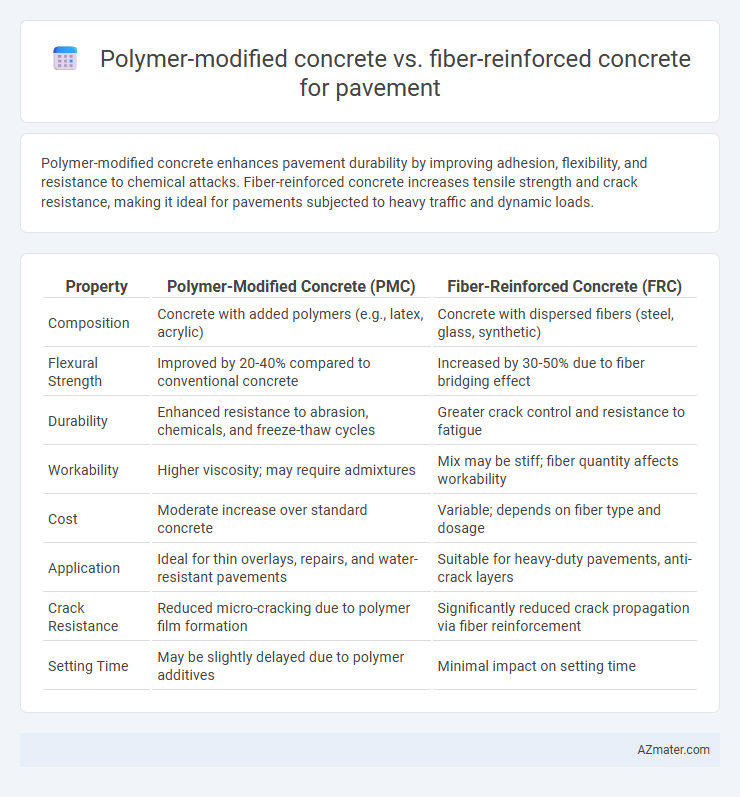Polymer-modified concrete enhances pavement durability by improving adhesion, flexibility, and resistance to chemical attacks. Fiber-reinforced concrete increases tensile strength and crack resistance, making it ideal for pavements subjected to heavy traffic and dynamic loads.
Table of Comparison
| Property | Polymer-Modified Concrete (PMC) | Fiber-Reinforced Concrete (FRC) |
|---|---|---|
| Composition | Concrete with added polymers (e.g., latex, acrylic) | Concrete with dispersed fibers (steel, glass, synthetic) |
| Flexural Strength | Improved by 20-40% compared to conventional concrete | Increased by 30-50% due to fiber bridging effect |
| Durability | Enhanced resistance to abrasion, chemicals, and freeze-thaw cycles | Greater crack control and resistance to fatigue |
| Workability | Higher viscosity; may require admixtures | Mix may be stiff; fiber quantity affects workability |
| Cost | Moderate increase over standard concrete | Variable; depends on fiber type and dosage |
| Application | Ideal for thin overlays, repairs, and water-resistant pavements | Suitable for heavy-duty pavements, anti-crack layers |
| Crack Resistance | Reduced micro-cracking due to polymer film formation | Significantly reduced crack propagation via fiber reinforcement |
| Setting Time | May be slightly delayed due to polymer additives | Minimal impact on setting time |
Introduction to Advanced Concrete Technologies for Pavements
Polymer-modified concrete enhances pavement durability by integrating synthetic polymers, improving flexibility and resistance to environmental stressors. Fiber-reinforced concrete incorporates various fibers such as steel, glass, or polypropylene to increase tensile strength and crack resistance in pavement structures. Both advanced concrete technologies provide significant improvements in pavement longevity and performance, tailored to specific load and climate conditions.
Overview of Polymer-Modified Concrete (PMC)
Polymer-modified concrete (PMC) enhances traditional concrete by incorporating polymers such as styrene-butadiene rubber (SBR) or acrylics, resulting in improved adhesion, flexibility, and chemical resistance. PMC exhibits superior durability against freeze-thaw cycles, reduced permeability, and better crack resistance, making it highly suitable for pavement applications subjected to heavy traffic and harsh environmental conditions. Compared to fiber-reinforced concrete, PMC primarily improves the concrete matrix's bonding and elasticity rather than relying on discrete fibers for reinforcement.
Overview of Fiber-Reinforced Concrete (FRC)
Fiber-reinforced concrete (FRC) enhances pavement durability by incorporating discrete fibers such as steel, glass, or synthetic materials to improve tensile strength, crack resistance, and impact absorption. FRC reduces shrinkage cracking and increases load-bearing capacity, making it ideal for high-traffic pavements and industrial floors. The fibers create a micro-reinforcement network, distributing stress more evenly and extending pavement lifespan compared to traditional concrete.
Key Material Composition Differences
Polymer-modified concrete incorporates polymers such as styrene-butadiene rubber or epoxy resins, enhancing adhesion, flexibility, and durability in pavement applications. Fiber-reinforced concrete contains discrete fibers like steel, glass, or polypropylene, which improve tensile strength, crack resistance, and impact toughness. The key distinction lies in polymers modifying the cement matrix chemically to enhance bonding, whereas fibers provide mechanical reinforcement by bridging cracks within the concrete structure.
Mechanical Properties: Strength and Durability
Polymer-modified concrete (PMC) exhibits enhanced tensile strength and improved adhesion, resulting in superior resistance to cracking and increased durability under varying environmental conditions. Fiber-reinforced concrete (FRC) integrates synthetic or steel fibers that significantly boost tensile and flexural strength while improving impact resistance and controlling shrinkage-induced cracking. Both PMC and FRC contribute to extending pavement lifespan by enhancing load-bearing capacity and resistance to mechanical stresses, with PMC excelling in bonding and chemical resistance and FRC offering better toughness and crack control.
Crack Resistance and Flexural Performance
Polymer-modified concrete enhances pavement crack resistance by improving adhesion and reducing permeability, leading to better durability under cyclic loading. Fiber-reinforced concrete improves flexural performance through the distribution of fibers that bridge cracks and increase tensile strength, resulting in higher crack control and toughness. Both materials offer significant benefits for pavement applications, with polymer modification excelling in crack resistance and fiber reinforcement providing superior flexural strength.
Workability and Construction Considerations
Polymer-modified concrete (PMC) offers enhanced workability with improved slump retention and reduced bleeding, making it suitable for fast-paced pavement construction in variable weather conditions. Fiber-reinforced concrete (FRC) enhances toughness and crack resistance but can reduce workability due to fiber entanglement, requiring specialized mixing and placement techniques to maintain uniform fiber distribution. Construction considerations for PMC emphasize compatibility with curing compounds and careful dosage of polymers, while FRC demands adjustments in equipment and labor to manage fiber dispersion and avoid clogging in narrow pavement joints.
Cost Implications and Lifecycle Analysis
Polymer-modified concrete (PMC) generally incurs higher initial costs due to expensive polymer additives but offers enhanced durability and resistance to chemical attacks, leading to reduced maintenance expenses over the pavement lifespan. Fiber-reinforced concrete (FRC) typically presents moderate upfront costs with fibers improving tensile strength and crack resistance, which extends pavement life and lowers repair frequency. Lifecycle analysis reveals that while PMC's upfront investment is greater, its superior longevity and maintenance savings can result in a lower total cost of ownership compared to FRC in demanding pavement applications.
Typical Applications in Pavement Engineering
Polymer-modified concrete (PMC) is commonly used in pavement engineering for applications requiring enhanced durability, improved bonding, and resistance to chemical attacks, such as airport runways, bridge decks, and highway overlays. Fiber-reinforced concrete (FRC) is preferred in pavements subjected to high tensile stresses and crack resistance needs, including industrial floors, heavy-duty pavements, and slabs-on-grade where impact and fatigue performance are critical. Both materials improve pavement service life, but PMC excels in surface wear resistance while FRC provides superior structural reinforcement and crack control.
Comparative Summary: Choosing the Right Concrete Solution
Polymer-modified concrete enhances pavement durability and chemical resistance by integrating polymers that improve bonding and flexibility, making it ideal for heavy traffic and harsh environments. Fiber-reinforced concrete incorporates synthetic or steel fibers to increase tensile strength, crack resistance, and impact absorption, offering superior performance in freeze-thaw cycles and fatigue-prone areas. Selecting the right concrete depends on project-specific requirements such as load conditions, environmental exposure, maintenance costs, and longevity expectations.

Infographic: Polymer-modified concrete vs Fiber-reinforced concrete for Pavement
 azmater.com
azmater.com